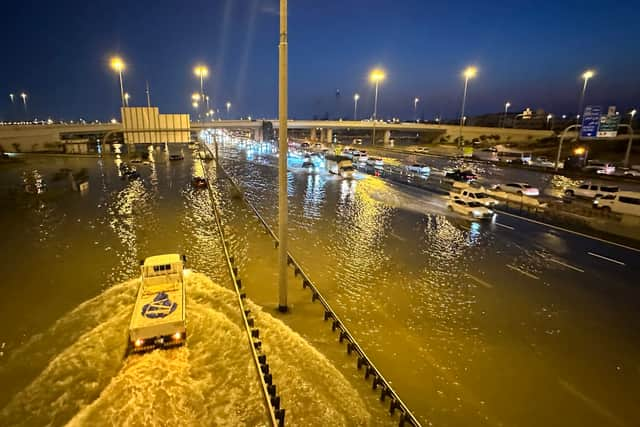Cloud seeding Dubai: Record-breaking rain and floods in Dubai linked to cloud seeding - what is it and did it cause the extreme weather?
and live on Freeview channel 276
Dubai has been hit by what the government has described as the heaviest rainfall in the past 75 years. In the hours that followed the floods, users on social media were quick to attribute the extreme weather to recent cloud seeding operations in the country.
Cloud seeding involves manipulating existing clouds to help produce more rain. This can be done by using aircraft to drop small particles (like silver iodide) into clouds. Water vapour can then condense more easily and turn into rain.
Advertisement
Hide AdAdvertisement
Hide AdThe technique has been around for decades, since 2002, and the UAE has used it in recent years to help address water shortages. Bloomberg also reported that cloud seeding had led to the heavy rain that caused catastrophic flooding throughout the region.


However, one of the UAE’s main newspapers, The National, rejected claims that cloud seeding was responsible for the flash floods. But it did say that it could have played a minor role.
Professor Diana Francis, head of the Environmental and Geophysical Sciences at Khalifa University in Abu Dhabi, told BBC News: "When such intense and large scale systems are forecasted, cloud seeding - which is a costly process - is not performed because [there is] no need to seed such strong systems of regional scale”. BBC Weather meteorologist Matt Taylor also added that the severe weather event had already been forecast.
He said: "Ahead of the event, computer models (that don't factor in potential cloud seeding effects) were already predicting well over a year's worth of rain to fall in around 24 hours”. According to The Telegraph, the University of Reading also denied the cloud-seeding technique was to blame for the extreme flooding. The team at the University told the paper that even if cloud seeding had been carried out in the days running up to the storm it could not have caused the extreme weather event.
Advertisement
Hide AdAdvertisement
Hide AdOn Tuesday morning (16 April), the UAE's National Centre of Meteorology issued a weather warning for large swathes of the country, including Abu Dhabi, Dubai and Sharjah. In Bahrain, footage showed cars stranded in flooded roads. The main road connecting Dubai to the capital, Abu Dhabi, was also gridlocked due to flooding.
Authorities in Oman said at least 18 people had been killed by floods and there was huge disruption to Dubai Airport which is continuing today (Thursday 18 April). The vast majority of flights to and from Dubai have been either cancelled, diverted or heavily delayed.
Comment Guidelines
National World encourages reader discussion on our stories. User feedback, insights and back-and-forth exchanges add a rich layer of context to reporting. Please review our Community Guidelines before commenting.
